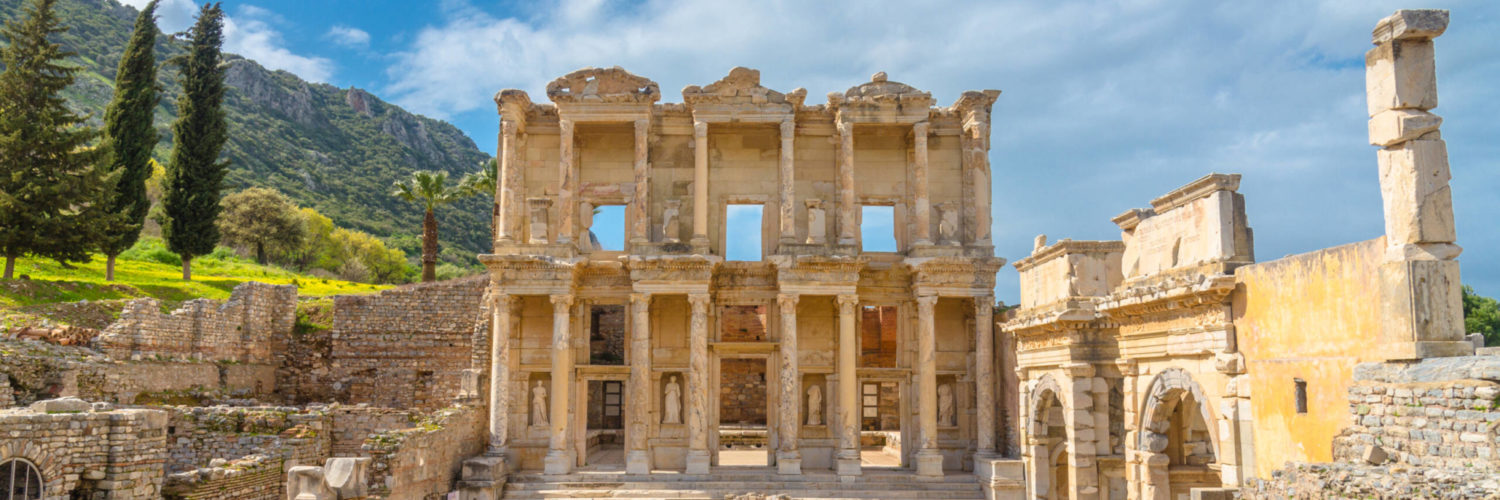Temples in Turkey always attract history lovers. Turkey’s magnificent temples and building structures fascinate tourists. Turkey is already known all over the world for its magnificent architecture and magnificent nature and therefore people from various countries flock to this beautiful country. These beautiful temples in Turkey add a new one to the list of reasons to visit this place.
Contents
Do you need a ride while traveling Turkey? With Yolcu360 car rental options, you can easily reach your car within minutes.
-
Ephesus Temple, İzmir

Ephesus was an ancient port city on the Aegean Sea that dates back somewhere around 3.000 years ago to Ancient Greek times. However it was at its peak about 2.000 years ago during the Roman times. So, most of the ruins you’re going to see here are from the Romans.
Ephesus was the second largest city in the Roman Empire, exceeded only by Rome itself. It’s estimated around 250.000 people lived here at Ephesus at its peak and only a small percentage of this city has been excavated at this point. So, there is still so much left here that has not been uncovered yet that really is unbelievable.
-
Gobekli Tepe Temple: Oldest Temple on Earth, Şanlıurfa

Gobekli Tepe is so old, so monumental, it is changing our understanding of the ancient world. On the edge of the fertile crescent, the cradle of civilization in southeastern Turkey. Massive limestone pillars rise into the air.
It’s about 12.000 years old (10.000 BC). The site of Gobekli Tepe is not actually considered to be a city. There is no evidence of people living there, cooking, supplies and buildings suggesting that they had homes within this ancient site. It is more of a temple complex sanctuary spiritual worshiping area. However, of course, it speaks to evidence of human civilization.
-
Aphrodisias Temple, Aydın

Aphrodisias was a small ancient Greek Hellenistic city in the historic cultural region of Western Anatolia Turkey. Aphrodisias was named after Aphrodite, the Greek goddess of love who lived here. Her unique cult image the Aphrodite of Aphrodisias according to the Sudha a Byzantine encyclopedic and compilation before the city became known as Aphrodisias in the 3rd century BC.
During The Antiquity period when it was within the Byzantine Empire the city was renamed Starapolis or City of the Cross. In 2017 it was inscribed on the UNESCO World Heritage Site list.
-
Behramkale Temple, Çanakkale

The history of the ancient city of Assos goes back to the 6th century BC. In the past, the city turned its face to the sea and descended to the sea with terraces. After the settlement of the Ottomans, the settlement developed in the opposite direction and the village of Behramkale emerged.
The city was founded on an extinct volcanic hill, between andesite cliffs, at a height of 236 meters from the sea. Andesite stone, which is abundant around Assos, was used in the construction of the city. Assos stone is a hard-working but very durable stone. The ancients called it man eater. Sarcophagi made of this stone were a product exported from Assos at the time.
The first archaeological excavation in Assos was made by an American archeology group between 1881 and 1883. The excavations started again in 1981, and the necropolis, or cemetery, was first unearthed.
In the northern corner of the Acropolis, there is a single-domed mosque built by the Ottoman Sultan Murat I in the 14th century. The bridge from the Ottoman period in the borders of Behramkale village is completely standing and people are still using it.
-
Apollos Temple, Didim

It was one of the biggest temples of the Ancient Greek World and its oracle was the second most important after the one in Delphi. There was a temple dedicated to Artemis the twin sister of Apollo in this area. That’s why the place was called Didyma which means twins in ancient Greek.
The first temple that was built here in the 8th century BC was very small and simple. In the 6th century BC, construction of a much larger temple. It was destroyed in the 5th century by Persians.
The construction of a new temple started with donations of Alexander the great. It continued for centuries but was never completed. So, when you look at the temple’s massive columns, you can see that they remained unfinished.
The temple was anyway used and kept its importance during Roman times and was later converted into a church. Didyma was not an ancient city but a worship place.










Add comment